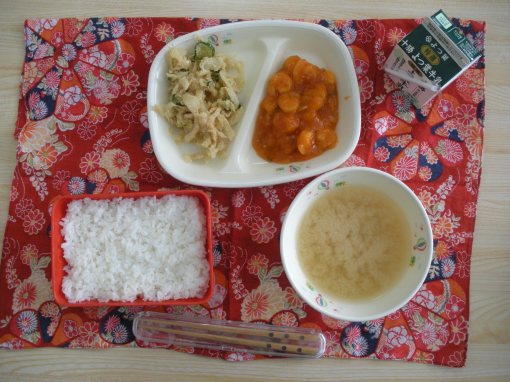March 8th, Friday:
- Miso Soup (Tamogi Mushroom, Tofu, Trefoil)
- Chili Shrimp (Shrimp, Onion, Green Onion)
- Sesame Vinegar Dressed Cabbage and Bean-curd (Cabbage, Cucumber, Beancurd)
- Rice
- Milk
- Kcal: 874
Shrimp are said to live until their backs are bent, so they are a symbol of long life. Celebratory meals such as at new year’s are not the same without them.
Today’s lunch was the best! Note the complete absence of meat. The cabbage was surprisingly sweet, vaguely similar to the flavouring of inari sushi. I liked the chili shrimp too. It was slightly spicy, which means it wasn’t spicy at all by many foreigners’ standards, but even so, one of the teachers worried about what students who dislike spiciness were supposed to do. I personally don’t like spicy foods, and spicy foods by Western standards make me feel physically ill the next day or two after eating them. Really, I think spiciness is something you grow accustom to, so if you grew up in a country with spicy cuisine, you can probably enjoy a lot, but if you didn’t, then it is not good for you to eat it. Japanese food, on the whole, is not spicy at all and tends to have very subtle flavours. This perfect for someone like me, but I could see how some people might dislike that.
みそ汁
エビチリ
キャベツと油揚げのごま酢和え
ごはん
牛乳











